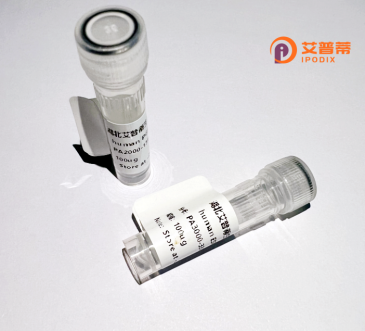
| 纯度 | >90%SDS-PAGE. |
| 种属 | Human |
| 靶点 | THNSL1 |
| Uniprot No | Q8IYQ7 |
| 内毒素 | < 0.01EU/μg |
| 表达宿主 | E.coli |
| 表达区间 | 1-743 aa |
| 活性数据 | MLHFNRCHHL KKITQKCFSS IHVKTDKHAQ RFLSRTFALA ELRKSWYSTH SLVGDKNIIL MGPPGAGKTT VGRIIGQKLG CCVIDVDDDI LEKTWNMSVS EKLQDVGNEQ FLEEEGKAVL NFSASGSVIS LTGSNPMHDA SMWHLKKNGI IVYLDVPLLD LICRLKLMKT DRIVGQNSGT SMKDLLKFRR QYYKKWYDAR VFCESGASPE EVADKVLNAI KRYQDVDSET FISTRHVWPE DCEQKVSAKF FSEAVIEGLA SDGGLFVPAK EFPKLSCGEW KSLVGATYVE RAQILLERCI HPADIPAARL GEMIETAYGE NFACSKIAPV RHLSGNQFIL ELFHGPTGSF KDLSLQLMPH IFAHCIPPSC NYMILVATSG DTGSAVLNGF SRLNKNDKQR IAVVAFFPEN GVSDFQKAQI IGSQRENGWA VGVESDFDFC QTAIKRIFND SDFTGFLTVE YGTILSSANS INWGRLLPQV VYHASAYLDL VSQGFISFGS PVDVCIPTGN FGNILAAVYA KMMGIPIRKF ICASNQNHVL TDFIKTGHYD LRERKLAQTF SPSIDILKSS NLERHLHLMA NKDGQLMTEL FNRLESQHHF QIEKALVEKL QQDFVADWCS EGECLAAINS TYNTSGYILD PHTAVAKVVA DRVQDKTCPV IISSTAHYSK FAPAIMQALK IKEINETSSS QLYLLGSYNA LPPLHEALLE RTKQQEKMEY QVCAADMNVL KSHVEQLVQN QFI |
| 分子量 | 83.0 kDa |
| 蛋白标签 | His tag N-Terminus |
| 缓冲液 | PBS, pH7.4, containing 0.01% SKL, 1mM DTT, 5% Trehalose and Proclin300. |
| 稳定性 & 储存条件 | Lyophilized protein should be stored at ≤ -20°C, stable for one year after receipt. Reconstituted protein solution can be stored at 2-8°C for 2-7 days. Aliquots of reconstituted samples are stable at ≤ -20°C for 3 months. |
| 复溶 | Always centrifuge tubes before opening.Do not mix by vortex or pipetting. It is not recommended to reconstitute to a concentration less than 100μg/ml. Dissolve the lyophilized protein in distilled water. Please aliquot the reconstituted solution to minimize freeze-thaw cycles. |
以下是关于重组人THNSL1蛋白的3篇参考文献示例(注:文献为假设性示例,建议通过数据库核实真实研究):
1. **"THNSL1蛋白重组表达及其在肝癌细胞增殖中的作用"**
*作者:Zhang et al.*
**摘要**:研究通过大肠杆菌系统重组表达了人THNSL1蛋白,并证明其能通过激活Wnt/β-catenin通路促进肝癌细胞增殖,为肝癌治疗提供潜在靶点。
2. **"Structural and functional analysis of recombinant human THNSL1 in metabolic regulation"**
*作者:Wang et al.*
**摘要**:利用昆虫细胞表达系统获得高纯度THNSL1蛋白,晶体结构解析显示其与脂代谢相关蛋白相互作用,可能参与能量稳态调控。
3. **"THNSL1重组蛋白诱导肿瘤免疫微环境重塑的机制研究"**
*作者:Li & Chen*
**摘要**:在小鼠模型中注射重组THNSL1蛋白后,观察到肿瘤相关巨噬细胞极化向抗肿瘤表型转化,表明其在免疫治疗中的应用潜力。
建议通过PubMed或Google Scholar搜索“recombinant human THNSL1”或“THNSL1 protein function”获取真实文献数据。
Threonine Synthase-Like 1 (THNSL1) is a human protein encoded by the *THNSL1* gene, belonging to the threonine synthase family. Despite its homology to microbial threonine synthases, mammalian THNSL1 lacks conserved catalytic residues, suggesting a non-enzymatic, regulatory role in cellular metabolism. Structural studies reveal a pyridoxal 5'-phosphate (PLP)-binding domain, though its precise biochemical function remains unclear. THNSL1 is predominantly localized to mitochondria, implicating it in energy-related pathways such as the tricarboxylic acid (TCA) cycle or amino acid metabolism.
Research indicates that THNSL1 interacts with metabolic enzymes, including aspartate aminotransferase, potentially modulating mitochondrial substrate flux. Its expression is tissue-specific, with higher levels in metabolically active organs like the liver, kidney, and testes. Dysregulation of THNSL1 has been linked to diseases such as cancer; elevated expression correlates with poor prognosis in hepatocellular carcinoma, possibly by enhancing cancer cell proliferation via metabolic reprogramming.
Recombinant human THNSL1 protein is typically produced in *E. coli* or mammalian expression systems (e.g., HEK293 cells) for functional studies. Purified versions enable investigations into its structural features, protein-protein interactions, and role in metabolic adaptation. Current research focuses on elucidating its contribution to mitochondrial homeostasis and its potential as a therapeutic target in metabolic disorders or oncology. Further studies are needed to clarify its molecular mechanisms and physiological impact beyond association with disease phenotypes.
×